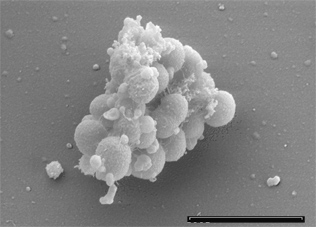User:S4354350
Name Morgan Freney Student No. 43543504 Bench ID B Date 31/08/2016 [1]
Classification
Higher order taxa
Kingdom: Bacteria, Phylum: Firmicute, Class: Negativicutes, Order: Selenomonadales, Family: Veillonellanceae, Genus: Veillonella, Species: Parvula.
In 2010, the genus Veillionella was emended by Marchandin and colleagues who reclassified all 26 genera of the Selenomonas-Megasphaera-Sporomusa group to the new order Selenomonadales in the new class Negativicutes, and divided into two families; Acidaminococcaceae and Veillonellaceae.
Species
Veillonella parvula; Prévot Te3T (= DSM 2008 = ATCC 10790 = JCM 12972)
Description and significance
Originally identified and named as Staphylococcus parvulus by Veillon and Zuber in 1898, Veillonella parvula (V. parvula) was later renamed in 1933 by Prévot. The first experiments were performed with organisms isolated from the human mouth by Langford in 1950.
Non-motile, non-sporulating, gram-negative bacteria. They grow as small cocci typically occurring as diplococci, in short chains or masses.
anaerobic and microaerophilic. It fluoresces red under UV light. reduces nitrate and lactate.
V. parvula is a commensal inhabitant of the oral cavity, gastrointestinal and genitourinary tract of homeothermic vertebrates.
Most significant is the ability of V. parvula to form a biofilm, where it can then participate in opportunistic multispecies infections. Only rarely has V. parvula been isolated in pure culture. It has been implicated in severe infections in diverse sites such as the lungs, sinuses liver, heart, bone and central nervous system.
Examples of citations [1], [2]
Genome structure
The genome of strain Te3T consists of a single circular chromosome 2,132,142 base pairs long with a 38.6% GC content. Of the 1,920 genes, 1,859 have been identified as protein-coding, 61 are RNA genes and there are 15 pseudogenes.
Cell structure and metabolism
Gram-negative surface layers consisting of an outer membrane composed of two dense layers 3nm wide separated by a less dense layer of 2nm, a thin peptidoglycan layer, and a cytoplasmic membrane. By negative staining, the outer membrane appears extremely convoluted. Although it is a Gram-negative organism harboring lipopolysaccharide, it is more closely related to Gram-positive species like Sporomusa, Megasphaera or Selenomonas, as they share cadaverine and putrescine in their cell walls.
Well known for its ability to ferment lactate. Veillonella parvula has an optimum growing temperature between 30-37 degrees Celsius and displays a pink to red fluorescence on brain heart infusion agar (BHI) containing either sheep or horse blood. The optimum pH is between 6.5-8.0.
It produces an atypical catalase containing porphyrin. Pyruvate, lactate, malate, fumarate, and oxaloacetate are all fermented. Carbohydrates and polyols are not fermented. Veillonellae are characterized by an unusual metabolism using methylmalonyl-CoA decarboxylase to convert the free energy derived from decarboxylation reactions into an electrochemical gradient of sodium ions.
Strain Te3T produces propionic and acetic acid, carbon dioxide and hydrogen from lactate and other organic acids like pyruvate, malate or fumarate. V. parvula cannot grow on succinate as a sole carbon source but can decarboxylate succinate during fermentation of lactate or malate. Veillonellae are unable to use glucose or other carbohydrates for fermentation and they do not possess a functional hexokinase. Nitrate is reduced and arginine dihydrolase is produced.
Ecology
V. parvula is typically found in the oral cavity, genito-urinary, respiratory, and intestinal tracts of humans and animals. It is found in the human mouth within the first three months of life. Dental plaque, buccal mucosa, and the tongue are the main ecological niches of V. parvula
Aerobic/ microaerophiles.
Another characteristic trait of veillonellae is their ability to form intergeneric coaggregates with other bacteria which occur in the same ecological niche. V. parvula utilizes the metabolic end products of co-existing carbohydrate-fermenting bacteria, thereby playing an important role in a natural microbial food chain.
While V. parvula cannot adhere to surfaces itself due to lacking flagella and adhesion structures. The bacterium circumvents this problem by attaching to specific surface structures present on other cells, mediated by lectin-carbohydrate interactions. The coaggregation creates a functional community providing nutrients and protection for all participants.
Potential other environments.
Pathology
Do these microorganisms cause disease in the oral cavity or elsewhere?
Application to biotechnology
Bioengineering, biotechnologically relevant enzyme/compound production, drug targets,…
Current research
Summarise some of the most recent discoveries regarding this species.
References
References examples
- ↑ MICR3004
This page is written by Morgan Freney for the MICR3004 course, Semester 2, 2016

